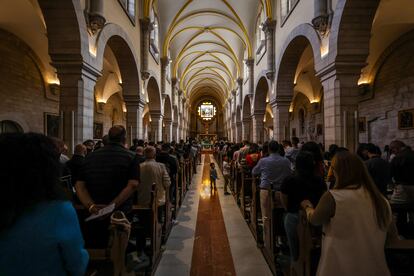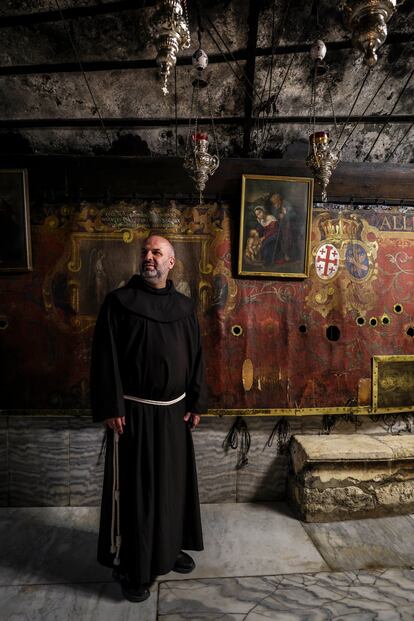Israel-Hamas conflict reaches Bethlehem as Christmas celebrations are canceled
The absence of foreign visitors has hit vendors of religious objects and tour guides in the holy city, where unemployment is on the rise

After more than 20 years, the shot in the back of the statue of St. Jerome, a reminder of the Second Intifada, goes unnoticed. The hundreds of Catholics who throng the Sunday Mass in the Basilica of the Nativity in Bethlehem, in the Israeli-occupied West Bank, hardly notice the bullet hole. The worshipers, who cannot move freely because of the war, form part of the 10% of Christians within the Palestinian population. They do not need tour guides or hotels, neither do they buy souvenirs in the local stores. The conflict between Israel and Hamas is sinking the main source of income in Bethlehem, a town of some 30,000 inhabitants: foreign pilgrims.
The war struck at a time when the town was rebounding from the coronavirus pandemic. “October 6 was the last time I accompanied tourists. The next day, the Israeli military checkpoints were closed. The tourists stayed in Jerusalem and went back to their countries,” says Ramsi Al Saadi, a 36-year-old guide, referring to the eve of the outbreak of the conflict between Israel and Hamas.
The outlook for a possible peace agreement in the short-term is gloomy. Christian Church leaders in Jerusalem announced on November 10 that there will be no Christmas festivities this year. “Despite our repeated calls for a humanitarian ceasefire and an end to the violence, the war continues,” they said in a statement. They justify the decision because of the thousands of innocent civilians who have lost their lives, the wounded, and those who have lost their homes and jobs or are being battered by the economic crisis.
“Masses and prayers will continue, because I think they will be more necessary than ever, but not feasts or chanting,” acknowledges Father Rami Asakrieh, a Jordanian Franciscan parish priest of the Catholic Church in Bethlehem. Ramsi Al Saadi is aware that without lights, decorations, gifts, street activities and, above all, tourist groups, survival will be more difficult. He does not have exact figures, but he is sure that the pre-conflict unemployment rate of 20% has skyrocketed. In a place like Palestine, a constant hotbed of tension, you have to be farsighted, he explains. “I get by because I have something saved up. Here we are used to war and we always think that something like this could happen to us.”

The road leading from Jerusalem to Bethlehem, barely 10 kilometers (6.2 miles) in length, has been cut off by Israeli forces since October 7, the day of the Hamas attack that left some 1,200 dead in Israeli territory and more than 200 hostages held in Gaza, the trigger for the current conflict. Reaching the Basilica of the Nativity now involves a journey of double the distance and crossing from the south through a military checkpoint that is not always open. The occupation and blockade, which has kept the West Bank’s population half-isolated for decades, is now much tighter. This directly affects the residents of Bethlehem and its surrounding villages who, thanks to a special permit, used to go to work in Jerusalem every day.
Some, like Jack Abdallah, who owns a restaurant in the Sheikh Jarrah neighborhood of Jerusalem and keeps his three children in school there, have had to make a drastic decision that is not available to many. He has left his home in the village of Beit Jala, just outside Bethlehem, and moved his whole family to his mother’s house in Jerusalem’s old city. “Now all six of us live in 31 square meters, but I can keep the restaurant open and my children can stay in school,” Abdallah says gratefully. Every Sunday, his family usually takes a trip to the house in Beit Jala, visiting the Basilica of the Nativity on the way.
A trickle of Palestinian believers, who kneel without having to wait their turn, passes through the grotto under the church where, according to tradition, a silver star marks the exact place of Jesus’ birth. Father Rami Asakrieh walks sorrowfully around, recalling the long lines at what before October 7 was one of the most visited Christian sites in the Holy Land.
There are approximately 50,000 Christians in Palestine, representing about 1% of the population. They are essentially distributed between Bethlehem, Ramallah, and Jerusalem, with some also in Gaza. Half of them are Orthodox and about 40% are Catholics. In the Bethlehem area, together with neighboring Beit Jala, Beit Sahour, and the Aida refugee camp, the number of Christians reaches 11%. Aida — where thousands of people live crammed together in the shadow of a 10-meter-high concrete wall erected by Israel — is a constant source of tension. The most recent death, that of a teenager, was recorded last Friday. On Sunday, dozens of people were still paying their respects to the family in streets lined with posters of the boy’s face.
The blockade imposed by Israel on Palestinians since October 7 has paradoxically doubled the number of local parishioners attending services in the Basilica of the Nativity, explains Father Asakrieh. The three naves were crowded with well-dressed families during the 11 a.m. Mass on Sunday, officiated in Arabic by several priests. The Jordanian Franciscan priest is tremendously popular, and many people come to greet him. Children hug his brown habit while, in the background, the choir intones hallelujahs from the altar.
“We have noted greater spirituality. People are afraid of the future, afraid for their country, and afraid for the little ones,” Father Asakrieh acknowledges as he strolls around the premises which, for more than a month, made the news all over the world in 2002. At that time, more than 100 Palestinians and several clergymen remained besieged by Israeli troops in the basilica without food, water or electricity before an agreement was reached. One of the many shots fired during that stand-off is the one that hit the back of the statue of St. Jerome.
Sign up for our weekly newsletter to get more English-language news coverage from EL PAÍS USA Edition
Tu suscripción se está usando en otro dispositivo
¿Quieres añadir otro usuario a tu suscripción?
Si continúas leyendo en este dispositivo, no se podrá leer en el otro.
FlechaTu suscripción se está usando en otro dispositivo y solo puedes acceder a EL PAÍS desde un dispositivo a la vez.
Si quieres compartir tu cuenta, cambia tu suscripción a la modalidad Premium, así podrás añadir otro usuario. Cada uno accederá con su propia cuenta de email, lo que os permitirá personalizar vuestra experiencia en EL PAÍS.
¿Tienes una suscripción de empresa? Accede aquí para contratar más cuentas.
En el caso de no saber quién está usando tu cuenta, te recomendamos cambiar tu contraseña aquí.
Si decides continuar compartiendo tu cuenta, este mensaje se mostrará en tu dispositivo y en el de la otra persona que está usando tu cuenta de forma indefinida, afectando a tu experiencia de lectura. Puedes consultar aquí los términos y condiciones de la suscripción digital.
More information
Archived In
Últimas noticias
Maduro pleads not guilty before the federal court in New York: ‘I am still the president of Venezuela’
A new test can detect Alzheimer’s from a finger prick
UN team enters Sudanese city of El Fasher after paramilitary massacre: ‘It’s like a ghost town’
A recipe for resistance: Indigenous peoples politicize their struggles from the kitchen
Most viewed
- Gilles Lipovetsky: ‘If you want to live better and fall in love, take Prozac, don’t look to philosophy’
- Alain Aspect, Nobel laureate in physics: ‘Einstein was so smart that he would have had to recognize quantum entanglement’
- Alvin Hellerstein, a 92-year-old judge appointed by Bill Clinton, to preside over Maduro’s trial in New York
- Why oil has been at the center of Venezuela-US conflicts for decades
- Maduro’s downfall puts China’s relationship with Venezuela to the test










































